6 ways to monetize videos without relying on YouTube
Want to monetize your original videos without using YouTube? Explore these 6 ways to make money from your videos without relying on YouTube or AdSense.
You keep hearing about YouTube sensations making millions from their channels.
The top YouTubers make it seem so easy.
You think to yourself: How in the world did they get all their subscribers?
After all, their content isn’t complex.
Yet, while you spend ages curating content for your YouTube subscribers, you’re not making money at all.
Hmm, there’s got to be a better way.
It’s not you, it’s YouTube.
Earning money from your video content isn’t as difficult as it seems, and you don’t need an outrageous number of subscribers to do it, either.
Today, we’ll explain how YouTube makes it nigh-impossible to monetize as a partner and, better yet, we’ll share six creative options for monetizing without YouTube.
But first, let’s cover what video monetization is so we’re all on the same page.
Looking for more monetization ideas? Sell digital downloads, coaching, courses, community, and webinars with Podia. Start for free!
What is video monetization?
Video monetization is when you earn income through the videos you create, publish, and share online on any platform.
That shouldn’t be misconstrued as getting paid to create videos, however. Instead, when you monetize your videos, you get paid to grant access either to your individual content, your viewers, or your platform (platform, in this case, being your content portal or library).
In other words, people either pay you to watch your videos and/or they pay to send a message to your video audience.
Typically, you generate revenue through advertising, subscriptions, or direct transactions and get paid when people watch, like, or subscribe to your video channels.
Let’s run through some actionable examples of the most common forms of video monetization.
#1. Access to your videos
Just as people pay to watch Hollywood movies at the local cinema, they can pay to watch your videos.
The environmental documentary, A Plastic Ocean , is a prime example of how you can sell viewing access directly from your site.
You can do the same by charging a fee to watch or download your individual videos.
The process is simple, too, especially if you use an all-in-one platform to sell your digital downloads from your own site . Once your content is live on your site, your videos are ready for customers to enjoy for a price.
Accessing your individual content isn’t your only option, either.
#2. Access to your audience
Similar to blog monetization methods , people can pay you to mention their products and services, either in your video or where your video is displayed. By paying you -- the creator -- for the mention, the sponsor gains exposure to a whole new audience.
For example, Blue Apron paid AsapSCIENCE to sponsor one of their channel episodes in exchange for a product mention in an episode and promo link in the description text.
As a result, AsapSCIENCE subscribers were exposed to Blue Apron’s service and promo offer as they watched, and since videos don’t have an expiration date, the exposure continues paying for itself over the long-term, even after the offer itself has expired.
A win-win all around.
In addition to selling access to your individual videos and audience, a third option is to sell access to your video portal or library.
#3. Access to your platform
You know how Netflix and Hulu charge you a monthly subscription to access their shows? You can do the same and charge a fee for access to your video content library.
For instance, Flex Lessons charges users a monthly subscription fee for unlimited access to their database of video content, which includes a vast library of prerecorded training videos.

You can follow in Flex Lesson’s footsteps by grouping related videos as helpful programs for your audience.
As far as revenue goes -- the larger your video audience, the larger your earning potential.
This proportional relationship is part of the unfortunate reason the eligibility requirements for YouTube’s Partner Program -- the flagship for monetizing your YouTube channel -- now require a minimum of 4,000 watch hours in the past 12 months and at least 1,000 channel subscribers.
Though, with video expected to account for 82% of online traffic by 2020, it’s no wonder that YouTube isn’t interested in smaller-scale fish.
It’s also little surprise that YouTube sensations rake in so much profit.
Check out some of these numbers. Two of the highest-paid YouTubers of last year are:
Ryan ToysReview - He’s made $22 million with over 25 billion views and 17 million subscribers
Dude Perfect - With over 36 million subscribers, this five-team channel has generated over $20 million
If these numbers and requirements sound intimidating to you, don’t worry, you’re not alone.
We aren’t recommending YouTube monetization strategies today. In fact, quite the opposite.
There are numerous monetization models. Among the top three are advertising, selling your own products, and consulting.
So as you can see, you’re not bound to the ways of YouTube.
Which brings us to our next point -- here’s how to monetize your videos without YouTube.
6 creative ways to monetize videos without YouTube
#1. Use affiliate marketing to make money promoting outside links
A great way to generate revenue from your YouTube channel is to include affiliate links in and around your videos.
Affiliate marketing has become a widely-used monetization method, and it’s dead simple to join the fray. All you need to do is link to outside products and services in exchange for a commission on each sale.
How popular is this strategy?
According to a survey of 500 publishers and 100 merchants, it’s the second highest-ranked revenue generator -- second only to Google AdSense.
76% claim affiliate marketing makes monetizing their site and content easy, and 45% say affiliate marketing doesn’t interrupt their user experience.
As you explore this video monetization option, it’s worth checking out these top affiliate networks:
If you’re wondering how lucrative affiliate marketing can be, WordPress SEO instructor and entrepreneur Tom Dupuis makes $1,000 a month by including annotations and descriptions with affiliate links.
Here’s a screenshot from one of his videos, so you can see where he includes his affiliate links:
Seems simple enough, right?
Like with any mention of an outside product, service, or business, it’s important to keep legal requirements for endorsements in mind and align your values with your affiliates.
In other words, be sure to agree with what your affiliates stand for, personally support their offering, and most importantly, ensure they match your audience’s needs.
Your audience should always come first.
Fortunately, serving your audience is a little easier with our next strategy by keeping the control and product squarely in your hands.
#2. Create a paid membership community for access to your video content
Another effective way to monetize your video content is to create a membership community for followers who enjoy your valuable material.
This method is an impactful way to feature you as an expert on your topic and to build an online community of fans who pay to access your videos.
A big benefit of running an online community is it allows you to maintain your customer base and earn recurring revenue over time. In exchange, you regularly publish helpful and engaging video content.
For example, Podia creator Anna Battle uses her community to sell instructional art videos. Fans pay $25 per month to access The Shiny Happy Art Club , where they receive dozens of painting videos and tutorials.
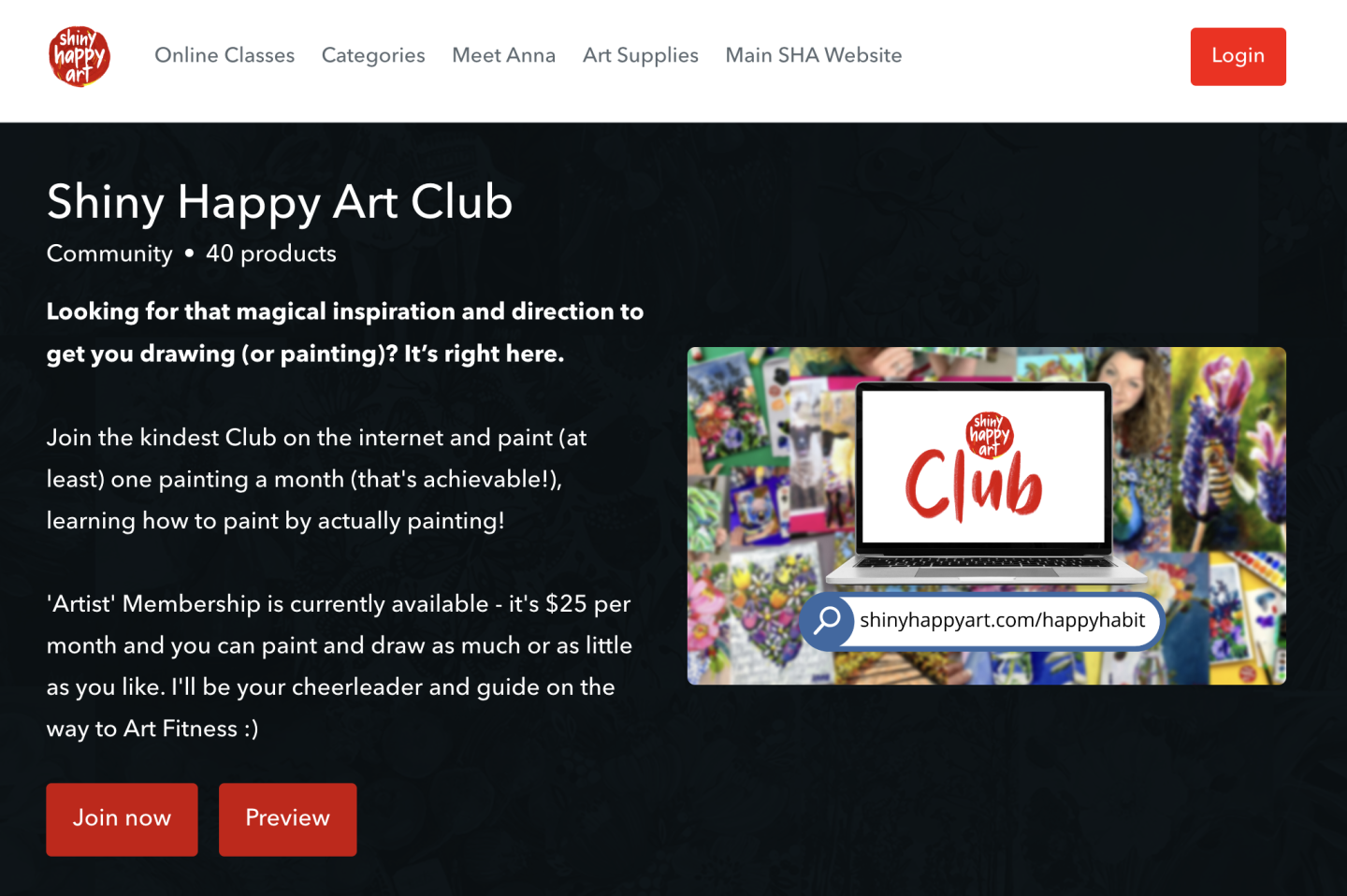
Likewise, members of Gemma Stafford's paid community, Bold Baking Academy , get access to three or four baking videos every month, as well as recipes, supportive forums, and livestream classes.
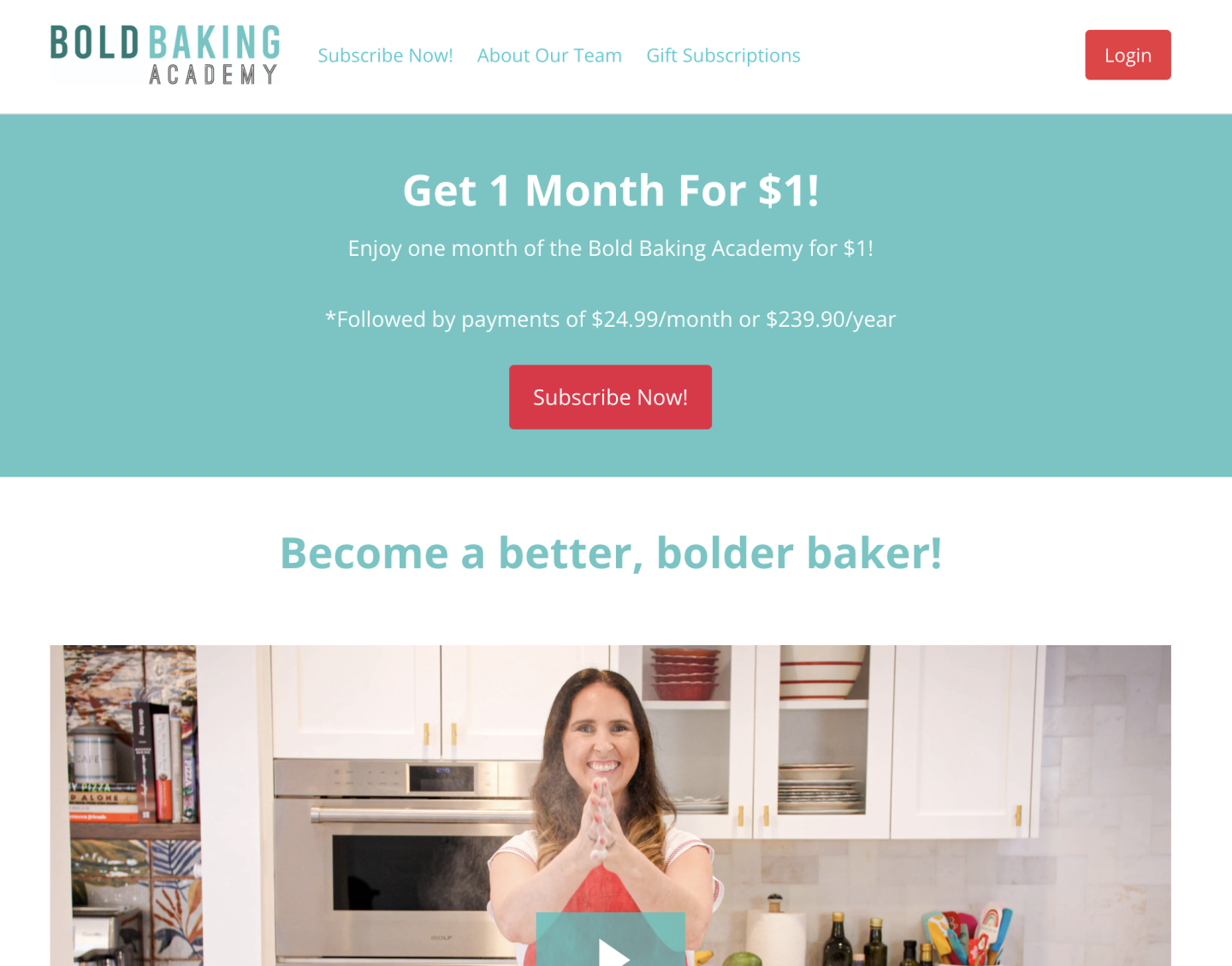
To set up your online community, you'll need a community platform that allows you to charge for access.
With Podia, you can set up a community with unlimited membership tiers on our free plan .
Running a successful community requires creating and publishing content regularly. Members are paying for your resources every month, so you should make a plan to consistently provide value.
If you do this, you have an opportunity to earn income by selling exclusive video content in the form of a paid community membership.
However, if you don’t want to maintain a community and regularly add new content, our next option may be better suited for you.
#3. Sell an online course to earn passive income
Another profitable way to monetize your video content is to scale your business and sell an online course .
If you have a growing video channel audience, it means your viewers are acclimated to watching you deliver valuable or entertaining content. Leverage this by turning their attention toward educational tutorials in an online course covering the same topic of interest.
Do online courses take more effort than a 3-to-4 minute video? Definitely. Is it worth it? Also definitely. Here’s why.
You can earn a significant income selling online courses, as proven by successful creators like Justin Jackson, who made $190,000 within a year selling his online courses and other profitable info products .
And creating an online course doesn’t have to mean lecturing for hours at a time. You can turn your bite-sized video content into an online course for sale, similar to Sheri Graham's Homeschool Curriculum Organization Course.

Her online course delivers three modules with videos, tutorials, and printables to help customers get more organized. Her engaging and streamlined video content is an excellent way to deliver a result for her customers.
That said, if you’d prefer a less-intensive option for monetizing your video than an online course, selling digital downloads is another proven model to consider.
#4. Offer digital downloads to your audience to increase your revenue
From ebooks to cheat sheets, selling digital downloads gives you limitless options for generating additional income.
Your topic range can cover the gamut, too.
For example, YouTuber and Podia creator Fei Wu sells a guide to landing YouTube sponsorships, a YouTube ad revenue tracker, and a video release roadmap spreadsheet.
She even gives away her own documentary series with instructions for how other creators can distribute their films independently.

Nice, right?
To help you brainstorm offers like Fei's, check out this list of popular digital download formats:
Written - ebooks, guides, templates, and other digital documents
Visual - photography, graphic designs, illustrations, fonts, icons, logos, design templates, and printable products
Video - short films, stock videos, documentaries, and animations
Audio - songs, beats, jingles, samples, tracks, and sound effects
Whichever format you decide to use, be sure to deliver something of value, which again, leads your audience to a specific result.
Why? It keeps them coming back for more, which is a vital momentum to take advantage of.
Here’s what I mean.
The likelihood of someone purchasing another product from you increases after their first, second, and third purchases with 27% likelihood after their first , 45% after their second, and 54% after their third purchase.
So, offer educational, valuable digital downloads to your video audience members. People are primed for purchasing online products -- all you need to do is get them in the door.
Main takeaway:
By selling digital downloads to your audience, you have an endless opportunity to drive revenue in the short and long term.
PS: You can sell your first digital download for free with Podia.
Of course, if creating a digital download or info product is too much for your current plate, you can take another route and partner up with outside businesses.
#5. Mention sponsors in your video
Another video monetization option is to mention sponsors in your video content.
Beyond including a link to outside products and services, a sponsored video typically involves a direct plug inside your video.
A humorous example of such a sponsored video is this Everything is Sponsored By Squarespace “sponsored video about sponsored videos”.
You can see the sponsor mention -- in this case, Squarespace -- is included in both the video and URL link in the description below.
Similar to the legalities of affiliate links, it’s imperative to disclose your inclusion of paid sponsor mentions.
If you’re curious about sponsor rate details, your sponsor typically pays you on a cost-per-view (CPV) metric.
For smaller channels, it usually means between $0.02 to $0.025 CPV and $0.06 to $0.09 CPV for channels with larger audiences.
Now, there’s one more video monetization strategy for you today. This one also involves partnering up with an outside entity, but it’s a lot easier to break into.
#6. Leverage larger audiences in partnerships
A final video monetization strategy is to partner with outsiders by offering an affiliate marketing program of your own.
Affiliate marketing program terms vary, but the basic idea is that you'll work with another creator to promote your digital downloads and info products using a designated tracking link. Once someone makes a purchase using one of those links, you'll pay the partner a predetermined commission.
The main benefit is you gain exposure to a broader audience, potentially increasing your revenue and customer base, while your partners get a cut of the profits. It’s another win-win.
It’s also an easy win. Here's how easy it is to set up your own affiliate marketing program using Podia. (Affiliate features are available on Podia's Shaker plan.)
Navigate to your dashboard and click “Affiliates”.

Select "Settings", then choose "Open" or "Invite-only" depending on how you want to structure your program.
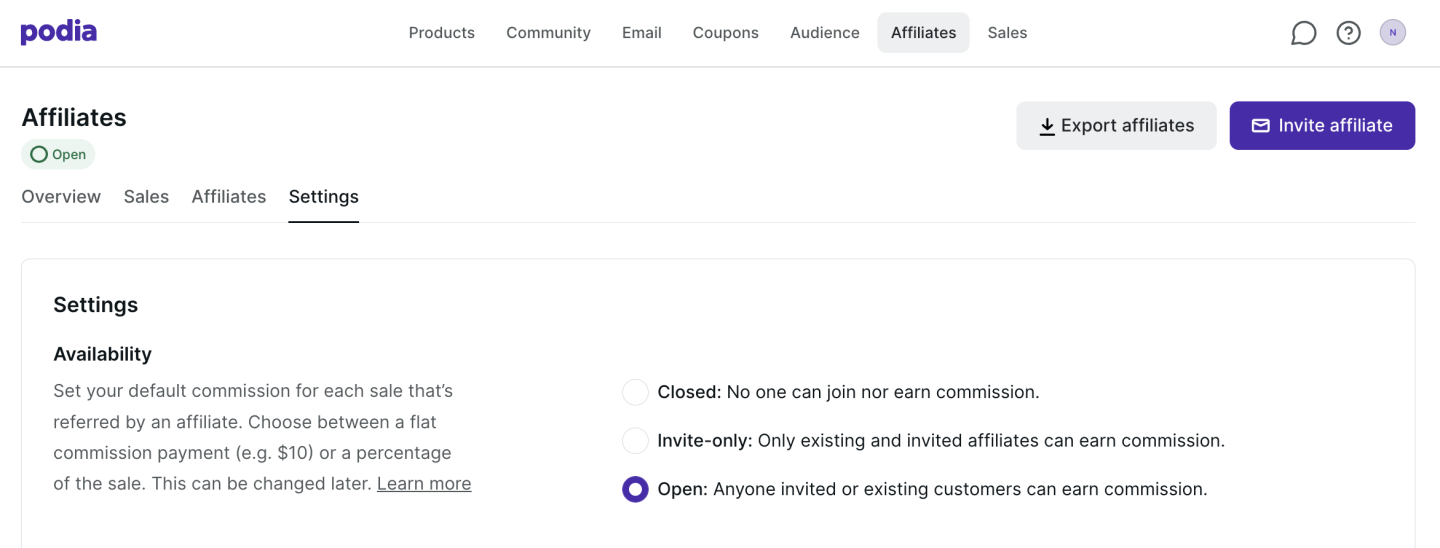
Enter the amount you want to pay your affiliates. You can pick a percentage or dollar amount. You can also set custom commission amounts for individual products.
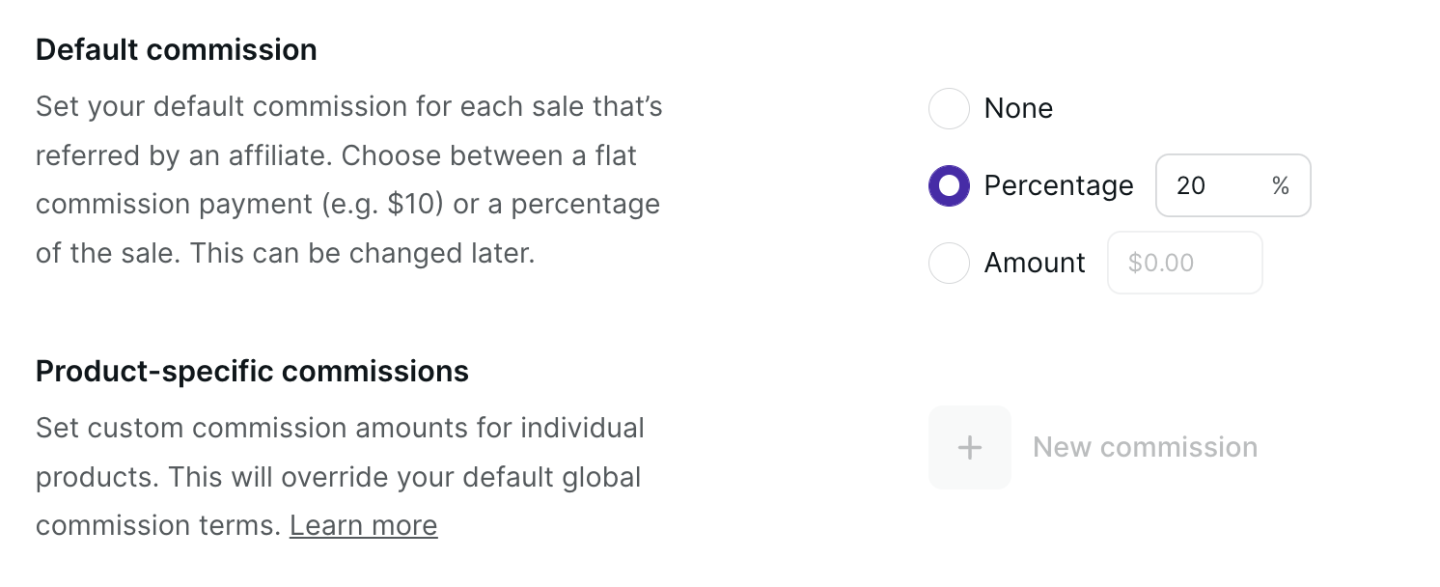
Pretty straightforward, right?
Now that you have these six creative strategies at your fingertips, let’s look at logistics on what tools and platforms you need.
What tools and platforms can you use to monetize videos on your website?
#1. Access platform sites to monetize your video content
Larger marketplace sites expose you to an expansive audience base, streamlining the search process for prospective customers and increasing your sales potential.
Here are some larger platform sites to consider:
Amazon - A simple “video” search in this substantial database turns up over 1 million results for sale, including videos and video-related apps.
iTunes - With over 112,00 movies available for rent or purchase -- similar to its music and podcast database -- iTunes is becoming a robust search engine for videos.
Vimeo - Vimeo allows you to both launch a video streaming service and sell videos directly to your fans. The company also offers distribution and marketing plans to help get the word out.
YouTube - At 1.3 billion users large, this is the obvious marketplace to use...
... However, because the platform giant has made it even more challenging to monetize your site (remember, you need over 4,000 watch hours and 1,000 subscribers), we recommend seeking alternatives.
That’s where the next two options come in.
#2. Tap into network sites to generate revenue from your videos
61% of US young adults watch TV from streaming services, making online networks an increasingly popular option for monetizing videos.
Streaming network sites aren’t only a useful monetization tool, but they also make it difficult for people to steal material, which alleviates any piracy issues .
Some video network sites worth reviewing are:
AwesomenessTV - What originally started as a YouTube channel, the Awesomeness Creator Network is made up of thousands of video creators who use the network’s community of influencers to build up their brands.
BridTV - BridTV is a video platform that provides ad serving solutions for creators and video publishers. The company focuses on supporting the latest technologies such as HTML5 video and AI-based technologies.
Disney Digital Network - Part of Disney’s larger ABC network, Disney Digital Network allows creators to partner up with Disney’s brand to promote campaigns to a global Gen Z and Millennial audience using targeted channels and influencers.
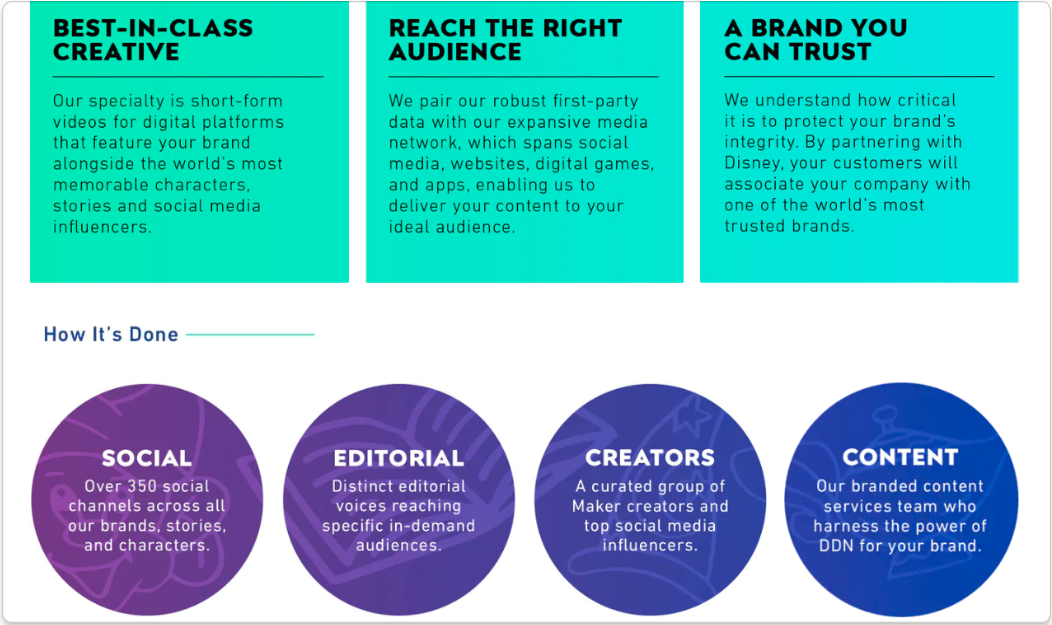
Twitch - A live streaming platform and subsidiary of Amazon, Twitch is an online community of creators and viewers who engage with video content, particularly in the video game niche.
However, while streaming video is an effective video distribution method, networks like these may charge various fees for promotional outreach efforts.
The most important factor is to find what’s right for your business and budget. For those with smaller distribution budgets, our third option is your best bet.
#3. Use your own site to earn a profitable income from your videos
Using your own site to monetize your videos offers you the biggest earning potential since you don’t have to share profits with anyone.
And that’s just one benefit.
The two other key advantages of selling digital downloads to your video audience from your own site include:
Better customer relationship management
Flexibility and independence
Managing your website and products on your own doesn’t mean it has to be a burden, either.
An all-in-one platform like Podia makes managing your products and website seamless. Best of all, you can sell one digital download, create an online community, and build your website on Podia's free plan.
Want to see how streamlined it can be? Get started today with a free Podia account .
To show you what an exemplary product page looks like, Becky Mollenkamp, the founder of the membership site Own It Crush It , offers a vast library of valuable content to her members for $1,500.
Becky’s site also includes complementary info products like PDFs, guides, and tip sheets to accompany her video content, giving her room to grow and net new customers who may not be ready to commit to the price tag of a full membership.
In a nutshell:
There are several places you can sell and distribute your video content including marketplace sites, network sites, and your own site. Choosing which to use depends on the needs of your business and audience in the short-term and over the long haul.
Earn a profit and creatively monetize your video channel beyond YouTube
As you’ve learned, YouTube isn’t the only way to make money from your video channel.
It’s also far from the easiest.
Let’s summarize your other options and what it means to monetize videos:
Video monetization allows you to earn an income from your videos, which you can do by providing paid access to either your videos, audience, or platform.
To monetize your video content, collaborate with outside entities in affiliate marketing programs, sponsorships, and partnerships.
You can also generate revenue by selling digital products to your video subscribers, such as paid memberships, online courses, and digital downloads.
A few helpful tools and platforms to use when monetizing videos include platform sites, network sites, and all-in-one tools that allow you to sell directly from your site.
With all these video monetization options available to you, are your creative juices flowing?
Good, then get out there and conquer. We’re rooting for you.


